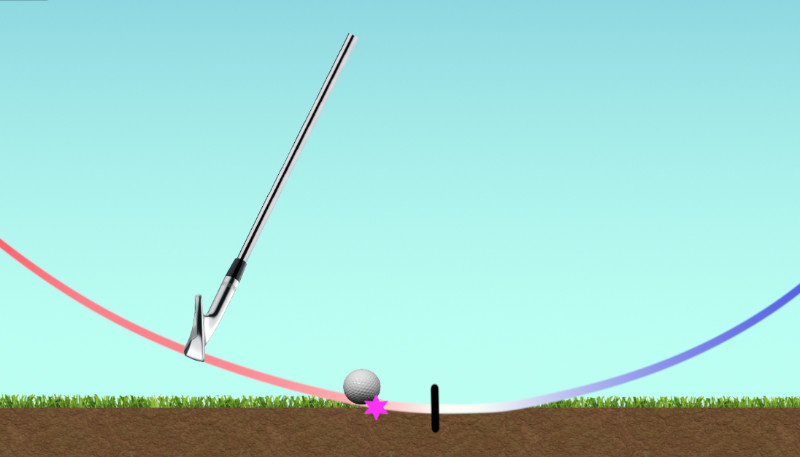EJS GOLF BLOG
Learn about the golf swing and what you can do to improve your score on the golf course. Fill out the form below if you have any questions or want to set up a time to talk.
Mastering the Art of Golf with Coach Erik Schjolberg
I’m Coach Erik Schjolberg, and welcome to the EJS Golf blog—Scottsdale’s authority on science-driven ball-striking. Here you’ll find in-depth analyses of swing mechanics, data-backed breakdowns of impact and launch dynamics, and actionable practice routines designed to rewire your muscle memory from day one. Each post peels back the curtain on cause-and-effect in your swing, whether you’re chasing Tour-level precision, collegiate consistency, or lower weekend scores. Dive into our deep-dive articles, master the drills that drive real improvement, and transform your game with proven science and strategy.
But let’s be clear: golf isn’t only about perfecting swing mechanics. The mental battle you fight on each tee is often the one that determines whether you stay in the game or walk off the course. Here, we’ll tackle the psychological hurdles—the pressure of a tight leaderboard, the frustration when a swing fails under stress, the self-doubt that creeps in after a bad hole. You’ll learn evidence-based mental strategies—visualization routines, pre-shot rituals, stress-management techniques—that fortify your focus and resilience. Mastering these mind-set tools is just as critical as dialing in your impact position, and I’ll show you exactly how to integrate mental training into your practice for lasting confidence on every shot.
Explore Our Blogs

Mastering the Low Point: The Science of Better Golf with EJS Golf
How to Strike the Golf Ball First
Hi friends and golfers! I'm Coach Erik Schjolberg, owner of EJS Golf at McCormick Ranch Golf Club in Scottsdale, AZ. With over 25 years of experience coaching golfers from PGA Tour pros to passionate amateurs, I'm dedicated to helping every player improve from their very first lesson. My state-of-the-art facility and data-driven approach guarantee results, whether you're seeking in-person Scottsdale golf lessons or online golf lessons. Visit my website, EJS Golf, to learn more about the Science of Better Golf and let's elevate your game together!

Notice in this picture how the ball is struck first and the low point is in front of the golf ball.
As a seasoned golf instructor who has spent countless hours on the sun-drenched courses of Scottsdale and engaging with students worldwide through online platforms, I’ve witnessed firsthand the transformative power of one fundamental concept: mastering the low point in the golf swing. This single aspect, often overlooked by many golfers, holds the key to unlocking unparalleled consistency and elevating your game to new heights. At EJS Golf, I’ve made it my mission to emphasize the importance of the low point in my coaching because I believe it’s the cornerstone of effective golf swing mechanics. Today, I want to delve deep into why the low point is so critical, how it impacts every shot you make, and why it has become such a significant focus in my teaching methodology. Whether you’re a beginner eager to learn or an experienced player looking to refine your skills, understanding the low point can make all the difference.
Let’s start by demystifying what the low point in the golf swing actually is. In essence, the low point refers to the lowest vertical point of the club head’s arc during your swing. Imagine the path your club takes from the start of your swing through impact with the ball and into your follow-through; the lowest point along this path is what we call the low point. This concept is crucial because it determines how your club interacts with the ball and the ground. If your low point is in the correct position relative to the ball, you’ll make solid contact, compressing the ball and achieving optimal flight and distance. However, if the low point is misplaced—either too far behind or ahead of the ball—it can result in mishits like fat or thin shots, robbing you of both distance and accuracy.
Understanding the low point is not just about avoiding mishits; it’s about embracing the science of better golf. At EJS Golf, we pride ourselves on integrating scientific principles into our coaching to provide students with a deeper comprehension of their swing mechanics. The low point is a tangible, measurable element that can be analyzed and adjusted. By examining factors such as angle of attack, swing plane, and weight distribution, we can make precise modifications that lead to significant improvements. This analytical approach is part of what sets EJS Golf apart and why we’re considered among the best golf instructors in Scottsdale and beyond.
Consistency is a word that resonates with every golfer, regardless of skill level. It’s the ability to reproduce desirable shots under varying conditions that separates good golfers from great ones. The low point plays an instrumental role in achieving this consistency. When you have control over your low point, you can reliably predict the quality and outcome of your shots. This predictability reduces the variables in your swing, allowing you to focus on strategy and execution rather than worrying about whether you’ll make solid contact. It’s a game-changer, and it’s why so many of my students experience dramatic improvements after focusing on this aspect.
One common issue that plagues golfers is the inconsistency of their low point due to flawed swing mechanics. Factors such as improper weight shift, casting (early release), and swaying can all contribute to an errant low point. For example, if you fail to shift your weight correctly onto your front foot during the downswing, your low point may occur behind the ball, leading to fat shots where the club digs into the turf before contacting the ball. Conversely, if you hang back on your rear foot, you might blade the ball, resulting in thin shots. In my coaching sessions, both in Scottsdale golf lessons and online golf lessons, I focus on identifying these mechanical issues. Through video analysis and targeted drills, we work on ingraining proper movements that promote a consistent low point.
Drills
Towel Behind the Ball Drill
Place a folded towel or small cushion approximately 6 inches behind your golf ball on the target line. The towel should be positioned about 1 to 2 inches behind your clubhead at address. The goal is to swing and strike the golf ball cleanly without making contact with the towel. This drill forces you to make ball-first contact, ensuring that your low point occurs after the ball.
How It Helps:
By introducing a physical obstacle behind the ball, you receive immediate feedback on your swing path and low point. If you hit the towel, it indicates that your club is bottoming out too early, leading to fat shots. Successfully avoiding the towel while striking the ball first promotes a forward low point and better compression, resulting in more solid and consistent shots.
Steps:
1. Setup:
• Place a golf ball on the ground in your normal hitting area.
• Position a folded towel or small cushion about 6 inches behind the ball, directly in line with your target.
• Ensure the towel is about 1 to 2 inches behind your clubhead when you address the ball.
2. Address Position:
• Take your normal stance with the ball positioned appropriately for the club you’re using.
• Align your body toward the target, maintaining proper posture and grip.
3. Focus Points:
• Concentrate on shifting your weight to your front foot during the downswing.
• Keep your hands ahead of the clubhead at impact to promote a downward strike.
• Maintain a smooth tempo and proper swing mechanics.
4. Execution:
• Begin with half swings to get accustomed to the drill.
• Swing the club, aiming to strike the ball cleanly without touching the towel.
• Focus on making a divot after the ball, indicating a forward low point.
5. Progression:
• As you become more comfortable, progress to three-quarter and full swings.
• Continue to monitor your contact and adjust as necessary.
6. Feedback:
• If you hit the towel, assess your swing to identify if you’re casting or not shifting your weight properly.
• Make adjustments and repeat the drill until you can consistently avoid the towel.
2. Alignment Stick Forward Press Drill
Place an alignment stick or a golf shaft on the ground parallel to your target line, about 2 to 3 inches ahead of the ball position (toward the target). The stick serves as a visual and physical cue. The objective is to make ball-first contact without striking the alignment stick. Start with short irons and half swings, gradually moving to full swings.
How It Helps:
This drill trains you to achieve a forward low point by promoting proper weight shift and a hands-forward position at impact. Avoiding the alignment stick encourages a downward strike on the ball, ensuring you compress the ball before interacting with the turf. It provides immediate feedback; hitting the stick signals that your low point is behind the ball.
Steps:
1. Setup:
• Place the ball on the ground in your normal position.
• Lay an alignment stick on the ground 2 to 3 inches ahead of the ball, in line with your target.
2. Address Position:
• Assume your normal stance and grip.
• Ensure that you’re aware of the alignment stick’s position relative to the ball.
3. Focus Points:
• Emphasize shifting your weight onto your front foot during the downswing.
• Keep your hands ahead of the clubhead at impact.
• Maintain a smooth, controlled swing.
4. Execution:
• Make half swings, focusing on striking the ball first and avoiding the stick.
• Observe the flight of the ball and the contact with the turf.
5. Progression:
• Increase to full swings as you gain confidence.
• Continue to monitor your swing to ensure consistent contact.
6. Feedback:
• If you hit the alignment stick, adjust your swing mechanics accordingly.
• Focus on improving weight transfer and delaying the release of the club.
3. Divot Awareness Drill
On a grass practice area, place a series of tees or coins on the ground where the ball would normally be. Remove the balls for this drill. Make swings attempting to strike the ground just ahead of the tees or coins, creating divots that start after the markers. This drill emphasizes awareness of where your club bottoms out relative to your setup position.
How It Helps:
By focusing on the starting point of your divots, you become more conscious of your low point control. The goal is to have the divot begin just after the ball position, indicating a forward low point. This drill helps develop a consistent swing bottom, leading to better contact and more predictable shots.
Steps:
1. Setup:
• Place several tees or coins in a line on the ground to represent the ball positions.
2. Address Position:
• Stand in your normal stance without a ball.
3. Focus Points:
• Concentrate on shifting your weight forward during the downswing.
• Maintain a steady head position and proper spine angle.
4. Execution:
• Swing the club, aiming to strike the ground just after each tee or coin.
• Observe the starting point and direction of your divots.
5. Feedback:
• Adjust your swing if the divot starts before the marker.
• Aim for consistency in divot placement across multiple swings.
4. Split-Grip Drill
Grip the club with your left hand in its normal position (for right-handed golfers), but place your right hand lower on the grip, leaving a gap of about 2 to 3 inches between your hands. This split-grip setup exaggerates the feeling of the clubhead lagging behind your hands. Make slow, controlled swings focusing on maintaining this lag through impact.
How It Helps:
The split-grip drill enhances your awareness of the proper hand and clubhead relationship during the swing. It encourages a forward shaft lean at impact, which is crucial for a forward low point. By feeling the separation between your hands, you learn to keep the hands leading and prevent an early release, promoting better compression of the ball.
Steps:
1. Setup:
• Take your normal stance.
• Grip the club with your left hand at the top of the grip.
• Place your right hand lower on the grip, creating a gap between your hands.
2. Focus Points:
• Emphasize leading with your hands and keeping the clubhead trailing.
• Maintain a smooth tempo and proper swing plane.
3. Execution:
• Start with half swings to get accustomed to the feel.
• Swing the club, focusing on delaying the release and keeping your hands ahead.
4. Progression:
• Gradually increase to three-quarter and full swings.
• Continue to focus on the hand-clubhead relationship.
5. Feedback:
• If you feel the clubhead overtaking your hands, adjust your swing to maintain lag.
• Use video analysis to observe hand position at impact.
Consider the story of Tom, an amateur golfer who had been playing for years but couldn’t break through a scoring plateau. He came to me frustrated, feeling like he’d hit a ceiling. Upon analyzing his swing, I noticed that his low point was inconsistent due to an excessive lateral sway during his backswing and a lack of proper hip rotation on the downswing. This movement caused his low point to vary drastically from swing to swing. We began working on drills that emphasized a stable lower body and proper rotational movement. Over several weeks of dedicated practice, Tom began to see remarkable improvements. His ball striking became more solid, his distances more predictable, and he finally broke through his scoring plateau, lowering his handicap by six strokes.
These success stories aren’t rare anomalies; they’re common outcomes when students commit to mastering the low point. At EJS Golf, we believe that every golfer has the potential to improve significantly by focusing on fundamental aspects like the low point. My coaching philosophy is centered around personalized instruction that caters to the unique needs and goals of each student. Whether you’re taking in-person lessons in Scottsdale or participating in our online golf lessons, you’ll receive tailored guidance designed to help you understand and control your low point.
The benefits of mastering the low point extend beyond just better ball striking. It also enhances your ability to execute different types of shots. For instance, controlling the low point allows you to manipulate your trajectory and spin, enabling you to hit high, soft landing shots or low, penetrating ones depending on the situation. This level of control is essential for navigating the diverse challenges presented by different courses and weather conditions. It’s an advanced skill set that becomes accessible once you have a solid grasp of the low point concept.

In the age of technology, accessing high-quality golf instruction is more convenient than ever. Our online golf lessons bring the expertise of EJS Golf directly to you, no matter where you are in the world. Using state-of-the-art video analysis tools, we can dissect your swing in detail, pinpointing areas for improvement with the same precision as an in-person lesson. The flexibility of online learning means you can work on mastering your low point at your own pace, fitting practice sessions into your schedule without the need to travel. It’s part of our commitment to making the science of better golf accessible to all.
Another critical aspect I address is how equipment influences the low point. Club selection, shaft length, lie angle, and even the type of golf ball you use can affect your swing mechanics and, consequently, your low point. During our lessons, we assess your equipment to ensure it’s suited to your swing style and physique. Sometimes, minor adjustments to your clubs can facilitate better swing mechanics, making it easier to control your low point. This holistic approach ensures that every facet of your game is optimized for success.
I also emphasize the mental side of mastering the low point. Golf is as much a mental game as it is physical. Understanding the low point gives you confidence in your swing, which can alleviate anxiety and improve focus on the course. We work on visualization techniques, helping you internalize the feel of a proper swing where the low point is in the ideal position. This mental rehearsal complements physical practice, leading to more consistent performance during actual play.
Let me share another inspiring story, this time about Lisa, a high school golfer aspiring to play at the collegiate level. Lisa had a strong work ethic but struggled with inconsistency, particularly with her long irons. During our initial assessment, we found that her low point was too far behind the ball due to an early release of the clubhead and a tendency to lift up during the downswing. We implemented a series of drills focused on maintaining her spine angle and delaying the release of the club. Over the course of several months, Lisa’s ball striking improved remarkably. She began hitting her long irons with precision and added an average of 20 yards to her shots. Her improved performance caught the attention of college scouts, and she eventually earned a golf scholarship to a reputable university.
These stories illustrate the profound impact that mastering the low point can have, not just on your scorecard but on your overall enjoyment of the game. Golf becomes more rewarding when you play with confidence and consistency. At EJS Golf, we’re dedicated to helping you reach that level of play. Our comprehensive approach addresses both the physical and mental aspects of the game, ensuring you’re well-equipped to tackle any challenge on the course.
Golf improvement is a science, not a mystery. At EJS Golf Academy, I debunk the myth that golfers must "get worse before they get better." Through my data-driven approach and cutting-edge technology, I help players make immediate, tangible improvements. Experience this transformative method at McCormick Ranch Golf Club in Scottsdale or through my online coaching. Visit EJS Golf to discover how I can elevate your game using advanced techniques and personalized instruction. Let's unlock your potential for continuous improvement together.
In wrapping up, I can’t stress enough the significance of mastering the low point in your golf swing. It’s a fundamental element that, once understood and controlled, can lead to substantial improvements in your game. At EJS Golf, we’re committed to helping you harness this knowledge through personalized instruction, whether you’re attending our Scottsdale golf lessons or engaging with us online. Remember, the journey to better golf is a blend of science, practice, and passion. By focusing on key concepts like the low point, you’re not just playing the game; you’re mastering the science of better golf.
If you’re eager to experience these improvements firsthand and join the ranks of golfers who’ve transformed their game, I invite you to reach out. Let’s embark on this journey together, unlocking your full potential and bringing consistency and joy back to your golf experience. Contact EJS Golf today for the best golf instruction Scottsdale has to offer, or sign up for our comprehensive online golf lessons. The Science of Better Golf awaits you.
(480) 861-9370
Q&A Section
Q: What drills can help me improve my low point control?
A: There are several effective drills to help with low point control. One popular drill is the “Alignment Stick Drill,” where you place an alignment stick a few inches ahead of the ball and practice making swings that avoid hitting the stick, promoting a forward low point. Another is the “Divot Placement Drill,” focusing on where your divot starts and ends to ensure it’s occurring after the ball. Personalized drills tailored to your specific swing issues are most effective, which we provide during our lessons.
Q: How does weight shift affect the low point?
A: Proper weight shift is critical for controlling the low point. During the downswing, transferring your weight onto your front foot moves the low point forward, ensuring you strike the ball before the ground. If you hang back on your rear foot, the low point shifts backward, leading to fat or thin shots. Practicing weight transfer drills can help ingrain the correct movement.
Q: Can equipment changes help with low point issues?
A: Yes, sometimes equipment can influence your swing mechanics. Clubs that are too long, too heavy, or have an incorrect lie angle can cause swing compensations that affect the low point. During our sessions, we can assess your equipment and recommend adjustments or fittings to better suit your swing.
Q: Is mastering the low point beneficial for all types of shots?
A: Absolutely. While the ideal low point position may vary slightly depending on the shot (e.g., driver vs. wedge), understanding and controlling it is beneficial across all clubs. It allows you to adapt your swing to different situations, whether you’re hitting off the tee, from the fairway, or out of the rough.
Q: How does the low point relate to angle of attack?
A: The low point and angle of attack are closely related. The angle of attack refers to the vertical direction of the club head’s movement at impact. A forward low point typically results in a downward angle of attack, which is desirable for iron shots to compress the ball. Understanding this relationship helps in optimizing ball flight and spin.
What You Can Expect from Our Blog
1. Expert Insights on Swing Mechanics:
With over 25 years of experience as a PGA Professional Golf Instructor, I delve deep into the nuances of golf swing mechanics. My articles break down complex theories into understandable concepts, focusing on ground reaction forces (GRFs), biomechanics, and efficient energy transfer.
2. Advanced Technological Guidance:
Our academy is equipped with state-of-the-art tools like the Trackman 4 Launch Monitor, 3D Pressure Plates, and Hackmotion, among others. On the blog, I share how to leverage these technologies to gain precise feedback on your swing, helping you make informed adjustments and see measurable improvements.
3. Tailored Practice Routines:
My philosophy is built on the belief that improvement should be evident from the first lesson. I advocate a '15 minutes per day' practice model, designed to fit into your busy schedule while ensuring consistent progress. Each blog post aims to offer practice drills and routines that are easy to implement and effective in refining your skills.
4. Real Success Stories:
Read about the experiences of those who have trained at EJS Golf Academy. These testimonials not only inspire but also illustrate the practical application of our teaching methodologies and the real results achieved.
5. Interactive Learning:
We occasionally feature video tutorials and interactive content that allows you to visually grasp techniques and corrections. This blended approach helps reinforce learning and allows you to engage with the content actively.
How Our Blog Helps Golfers Get Better
Every post is crafted with the intent to educate. We cover everything from basic fundamentals to advanced techniques, ensuring there's something valuable for every skill level. By presenting data and evidence-backed strategies, our blog demystifies the 'why' and 'how' behind effective golf training. This analytical approach empowers you to make smarter decisions about your practice and play. We understand that generic advice does not suit everyone. Our blog posts are designed to help you identify your own needs and adapt our techniques accordingly. Whether it’s adjusting your grip, stance, or swing path, you’ll find personalized tips that resonate with your specific challenges. Beyond just reading, our blog serves as a community hub where you can interact with fellow golfers and share your experiences. This supportive environment encourages learning and improvement through collective wisdom.
Join Us on Your Path to Mastery
Whether you’re looking to refine your swing, understand the biomechanics of your body, or simply get more enjoyment out of the game, our blog at EJS Golf Academy is your go-to resource. Bookmark our page, subscribe to updates, and start transforming your game today.
Remember, at EJS Golf, we don’t just teach golf; we craft master golfers. Let’s begin this journey together. Visit us atEJSGolf.com to learn more about our programs and start your training online or at our Scottsdale location. Let’s make every swing count!
DO YOU HAVE QUESTIONS?
Fill out my contact form and I will respond to you within 24 hours.
phone: 480.861.9370 email: [email protected]

I've taken multiple private lessons with Erik and he's been by far the best swing coach I have ever worked with. He has the ability to dissect your swing and make small changes for big improvements. What I love most about his lessons is they go far beyond the 1 or 2 hours you're with him. He follows up with videos of how you can improve at home and on the range. The value he provides is absolutely worth the cost of his sessions. I would recommend any golfer at any level who truly wants to get better to go see Erik.”
- Reanol H.

Erik is the best! and that is not an exaggeration. There has not been a single lesson where I haven't walked out and felt like a far better golfer than before. What can't be praised enough is the effort and dedication that Eric puts into each of his students, as his approach to fixing and improving my golf swing was specific to me. While teaching, Erik takes the extra time to truly dive into what he is trying to convey rather than just telling you, allowing for a better understanding. Beyond the instruction at the course, Erik sends specific drills to you from an app that allows for slow motion replays, letting you break down everything and work on your game at any time. I genuinely mean it when I say that I would recommend Erik to anyone wanting to improve their golf game, as he is not only a top not instructor but also a top notch person who cares about his students.
- Brennan K.

Erik is flat out a great coach and mentor! I highly recommend him! Working from the ground up, my swing is healthier and smooth! I wanted a coach that shared the same main principles as the late Tony Manzoni and Erik hits the mark! Found Erik by listening to the Golf Smarter podcast by Fred Greene and connected with EJS Golf through the Perfect Motion app. Erik is motivated and incredibly gifted at his craft!
- Bryan B., Indiana, USA


